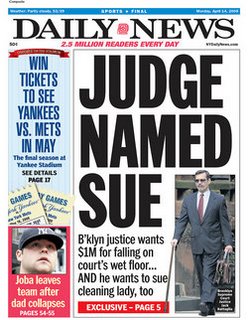I was pissed when I saw the article in the paper: A doctor walked her dog in a school playground where it wasn’t supposed to be and attacked a child, biting off part of his earlobe. The kid (through his parents) sued the doc. For $30,000,000.
Yeah, I was mad. But not at the doctor and not at the dog. I was mad at the lawyer, Rosemarie Arnold, who belches on one of her websites that she is the “Queen of Torts.”
Really? The Queen? Well, let’s see about that, shall we?
Wouldn’t the “Queen of Torts” have the fundamental knowledge that, when starting a personal injury lawsuit in New York, you are not allowed to put in an ad damnum clause? That’s the part where you state an actual amount of money. The Legislature killed that idiotic provision back in 2003. As Walter Olson noted at the time on Overlawyered, the measure enjoyed “widespread support from among both defense interests … and the plaintiffs’ bar, which is perennially embarrassed by news items…”
That law was amended because it is, most often, impossible to know the extent of an actual injury soon after it occurs, because the injury has not stabilized and it is too difficult to predict the future at that early point in time. Will the person need one surgery or five? Will the pain resolve itself in six months or not?
As a result of this problem, some lawyers would put crazy numbers in the complaint “just in case,” so that they would not be precluded later if the client’s health went downhill. At the same time, it was grossly unfair to the defendant, as newspapers loved to put this stupidity in headlines. This was particularly true in medical malpractice cases.
So the old law was, thankfully, changed by the Legislature.
Which brings us back to Rosemarie Arnold and her claim on behalf of the child that he suffered a $30M injury to his ear. There are only two reasons for Ms. Arnold to do this:
1. The Queen of Torts is actually ignorant of the law; or
2. Rosmarie Arnold willfully elected to ignore the law, in the hunt for headlines, thereby raising ethical issues about her willfully ignoring the law.
Neither of these scenarios is good for her, as one goes to the issue of ignorance and the other to the issue of ethics. Pick your poison.
Back in 2007, during my virgin year as a blogger, I first wrote about this issue. It’s time to expand on it, thanks to Rosmarie Arnold.
When I go in to pick juries, I am constantly faced with the deep cynicism that is fed by insurance companies and newspapers that thrive on outlier suits for spurious claims or that claim enormous damages. To the jurors, fed by such media attention, every lawsuit represents greed and lottery-like jackpots, while to the litigants, the suit is simply at attempt to measure what is fair and reasonable under the circumstances and receive just compensation.
Rosemarie Arnold, in bleating a $30M claim to the press, just made my job more difficult, as well as the jobs of all the other personal injury attorneys in the state. And she has added one more straw to the camel’s back in damaging the rights of litigants trying to pursue justice in the courts.
Perhaps the publicity she got from the suit was good for Ms. Arnold, but it was detrimental to the cause of civil justice. As is often the case, the bad conduct of a few people in a group taints the rest in the eyes of the public. There isn’t any group that wants to see its own misbehaving and damaging the reputation of the rest.
And on the cause of civil justice, since I’m on the topic, it’s worth noting that the self-proclaimed Queen of Torts isn’t even a member of the New York State Trial Lawyers Association, the premier bar association in the state that fights in Albany to protect the civil justice system from those who seek to damage it. Some Queen.
Frankly, I wouldn’t mind seeing this taken up by a judge or ethics committee.
I emailed Ms. Arnold using the form on her website two days ago, seeking comment, and no one got back to me.
 It is rare for me to discuss a local accident. But I do so today regarding the tree limb that fell over the weekend killing a 6 month old girl in Central Park that also critically injured her mother. She was holding the baby and posing for a picture being taken by the father on a clear summer’s day. It is, essentially, a trauma that could have happened to anyone.
It is rare for me to discuss a local accident. But I do so today regarding the tree limb that fell over the weekend killing a 6 month old girl in Central Park that also critically injured her mother. She was holding the baby and posing for a picture being taken by the father on a clear summer’s day. It is, essentially, a trauma that could have happened to anyone.

